Update: Sunday, 2/4 9:54 pm
I will score how well the NWS and MOS fared against the arctic air mass over the Saturday-Wednesday period. I will group the Bowling Green and Lexington forecast by day to make scoring easier. By the way, I made a pretty bad call on the high Saturday. I neglected to account for the lack of cold air advection (CAA) into Kentucky at 850 mb. Since we’re at the bottom of the trough, our winds aloft were westerly. Note how the winds aloft shift more to the northwest as the trough axis swings through the region on Sunday/Monday. This NW flow coincides with the coldest air of the season. I should have noticed this before I criticized the NWS forecast for Saturday. I am somewhat justified though as even the NWS admitted they were too warm with temperatures for the weekend in today’s discussion…
MAIN STORY MONDAY MORNING WILL BE THE COLD LOWS…0-5 ABOVE IN THE NE TO 5-10 ABOVE IN THE SW. THIS IS
CONSIDERABLY COLDER THAN THE MOS AS ITS SUFFERING FROM A WARM BIAS OF LATE. WEAK RIDGING WILL BUILD IN FOR MONDAY ALLOWING SKIES TO BECOME PARTLY SUNNY. HOWEVER…EVEN WITH GOOD INSOLATION…TEMPS NOT GOING TO GO UP VERY MUCH. TRENDED TEMPS DOWN FROM PREVIOUS FCST WITH MID AND UPPER 10S ACROSS THE NORTHERN HALF TO THE LOWER 20S ACROSS THE
FAR SOUTH. LOOKS LIKE COLDEST NIGHT WILL BE MONDAY NIGHT/TUESDAY MORNING WITH LOWS VERY CLOSE TO 0 IN THE BLUEGRASS REGION…COULD EVEN SEE SOME BELOW ZERO READINGS IN SHELTERED AREAS.
*************************************
The students in my Synoptic Meteorology course last fall know my feelings about the ability of model output statistics (MOS) to accurately predict temperatures of an arctic outbreak. Even better, my students know how I feel when forecasters use those MOS values even though they have no known basis in reality during arctic outbreaks. In fact, the inability of MOS to accurately predict highs and lows during arctic outbreaks is so well known there have been a number of research articles to prove this, as seen here, here and here. If this problem is so well known, then why is the NWS forecasting temperatures for much of Kentucky over the weekend that are in some cases higher than the MOS ensemble average? Continue reading →
